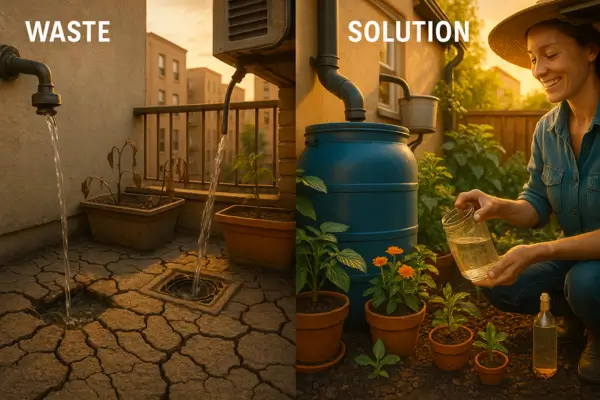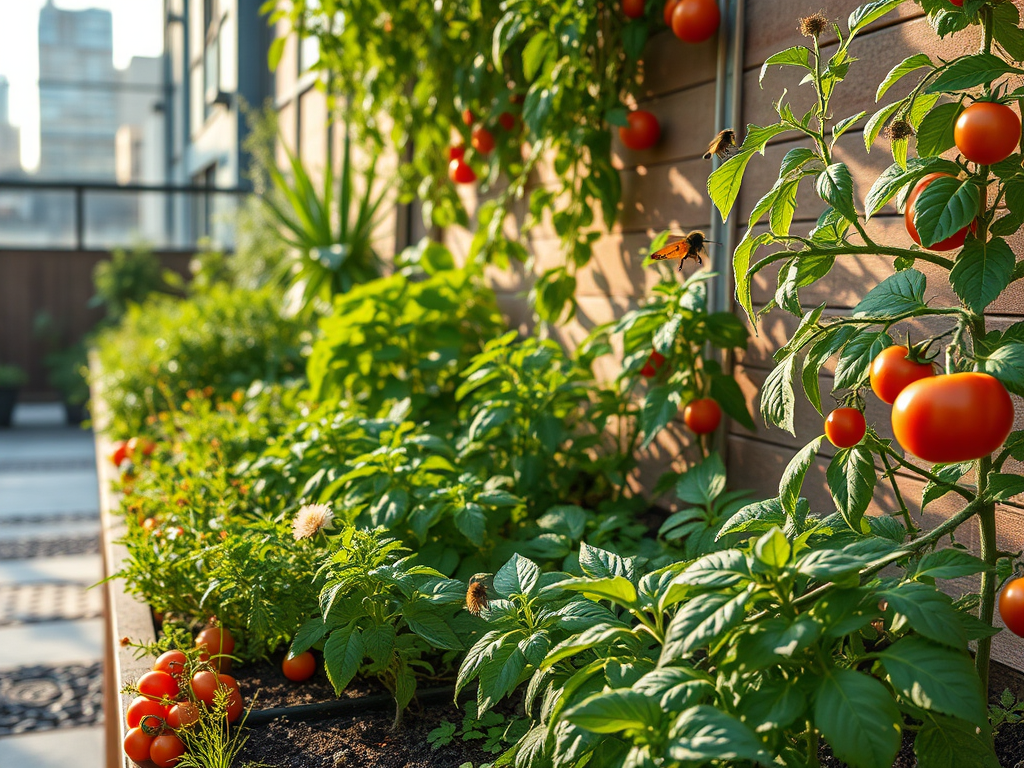Picture this: It’s another scorching summer in the city, and water restrictions are in full swing. Meanwhile, your neighbor’s garden is thriving with lush tomatoes and vibrant flowers—while yours struggles. What’s their secret? They’ve mastered the art of water reuse.
Here’s the reality: Urban areas waste billions of gallons of water annually—from rainwater washing into storm drains to perfectly good “greywater” from showers and sinks disappearing down the pipes. But what if you could slash your water bill by 30% or more (like my friend Sarah did) while keeping your garden green?
The truth is, every drop counts—especially when you live in a concrete jungle where water is precious. The good news? You don’t need a fancy setup or a big budget to start saving water today.
In this guide, we’ll explore nine clever, real-world-tested ways to reuse water in your city garden, including:
- How a Brooklyn apartment dweller waters her herb garden using just AC runoff
- The $5 trick one Portland gardener uses to double his rainwater harvest
- Why your pasta water could be your plants’ next favorite snack
These aren’t just eco-friendly ideas—they’re money-saving, plant-boosting hacks that work in real small spaces. Ready to turn your waste into growth? Let’s dive in.
“After implementing just three of these methods, I reduced my outdoor water use by 40%—and my plants have never looked better!”
— Marcus T., urban gardener, Chicago
Collect and Use Rainwater: Nature’s Free Happy Hour for Plants
Why Rainwater is Liquid Gold for Your Garden
Your plants secretly prefer rainwater over tap water—and here’s why:
- No chlorine or fluoride (which can harm soil microbes)
- Slightly acidic pH (perfect for most veggies and ornamentals)
- Free dissolved nitrogen (nature’s gentle fertilizer)
“My hydrangeas went from sad to spectacular when I switched to rainwater—the color change was unbelievable!”
— Priya K., rooftop gardener, Toronto
3 Easy Ways to Catch the Rain
1. The Classic Rain Barrel ($50-$150)
- How it works: Attach to a downspout with a diverter kit
- Pro tip: Elevate on cinder blocks for better water pressure
- Creative twist: Paint barrels to match your garden decor
2. Downspout Diverter + Storage ($20 DIY Special)
- Redirect water to:
- Repurposed food-grade drums
- IBC totes (275+ gallon capacity)
- Even a kiddie pool for temporary storage
3. Underground Cisterns (The Stealthy Solution)
- Ideal for:
- Small yards (hidden under decks)
- Cold climates (prevents freezing)
- Bonus: Connect to drip irrigation
Keeping Your Water Clean & Mosquito-Free
🚫 No-Bug Zone:
- Add 1/4 cup vegetable oil to create a surface barrier
- Install fine mesh screens (nylon works great)
- Empty barrels weekly if not sealed
💧 Crystal Clear Water:
- Use a “first flush” diverter (dumps the dirty initial rainwater)
- Throw in a handful of barley straw (natural algae preventer)
Pro Hack: Place your barrel near plants that need the most water—you’ll use gravity instead of hauling heavy watering cans!
(Up next: [2. Reuse Household Greywater – Your Shower Water is a Garden Superfood])
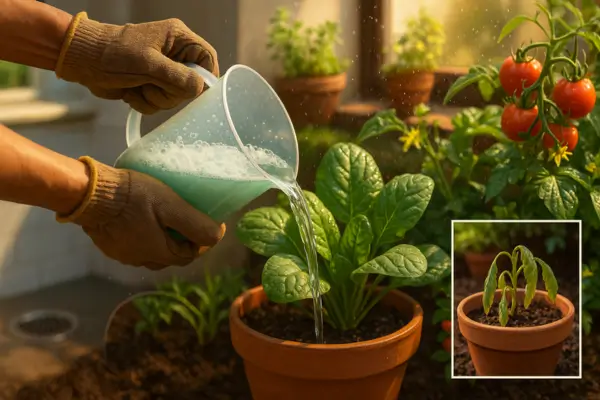
Reuse Household Greywater: Turn Your Daily Routines into Plant Superfood
What Exactly is “Safe” Greywater?
Not all wastewater is created equal. Here’s what your garden can handle:
✅ Great for Plants:
- Shower/bath water (mild soap is okay)
- Bathroom sink water (toothpaste water won’t hurt)
- Laundry water* (from eco-friendly detergents)
❌ Avoid These:
- Kitchen sink water (grease/food particles attract pests)
- Diaper/bleach-heavy laundry water
- Water softener discharge (salt kills plants)
“When I switched to plant-safe laundry detergent, my lemon tree started fruiting like crazy!”
— Diego R., balcony gardener, Austin
The Detergent Dilemma: What to Watch For
⚠️ Deadly Ingredients in Common Products:
- Sodium (softens water but destroys soil structure)
- Boron (found in some “natural” cleaners—toxic to plants)
- Chlorine bleach (microbe murderer)
🔍 Label Checklist:
✔ “Greywater-safe” or “OASIS certified”
✔ Biodegradable + phosphate-free
✔ Low sodium/salt content
Pro Tip: Run a test patch—water one plant for 2 weeks and compare.
2 Simple Systems Anyone Can Use
The Bucket Method (Free & Instant)
- Place a bucket in your shower
- Use captured water within 24 hours
- Apply directly to soil (not leaves)
Best For: Potted plants or small gardens
Branched Drain System ($50 DIY Project)
- Redirects shower water via 1″ PVC pipes
- Spreads flow through mulch basins
- Key: Use a 3-way valve to switch to sewer when needed
Pro Hack: Plant water-loving species (bananas, cannas) near drain outlets!
Greywater Golden Rules
🌱 No Storage (use within 24 hours to avoid bacteria)
🌱 Rotate Application Areas (prevents salt buildup)
🌱 Skip Edible Roots (okay for fruit trees, not carrots)
(Coming Next: [3. Repurpose Cooking Water – Your Pasta’s Secret Second Life])
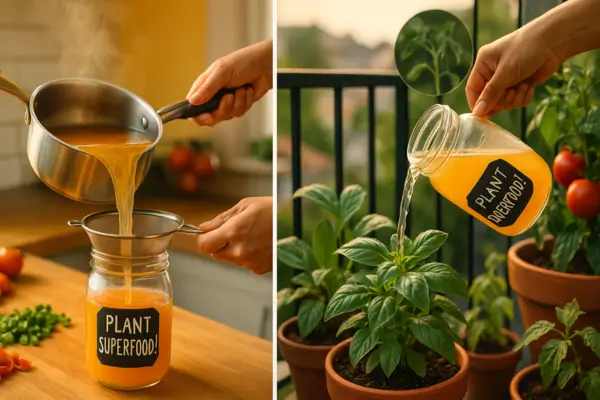
Repurpose Cooking Water: Your Kitchen’s Secret Fertilizer Factory
The Science Behind the Magic
That murky pasta water isn’t just leftovers—it’s liquid plant fuel! Here’s why:
🔬 Starch Benefits
- Feeds soil microbes (which convert nutrients into plant-available forms)
- Acts as a natural chelating agent, helping roots absorb minerals
- Creates a protective biofilm around roots during drought stress
“My tomato plants grew 30% larger after I switched to weekly starch water treatments!”
— Carlos M., urban farmer, Phoenix
Weekly Meal Prep Water Schedule
📆 Monday (Pasta Night)
- Reserve unsalted water → dilute 1:2 → use on fruiting plants (tomatoes, peppers)
📆 Wednesday (Veggie Steam Day)
- Broccoli/carrot water → cool → apply to leafy greens (spinach, kale)
📆 Saturday (Egg Breakfast)
- Calcium-rich boil water → strain → water flowering plants (1x/month)
Pro Tip: Label containers with reuse dates to track freshness!
Warning Signs of Over-Fertilizing
🚩 Leaf Burn (brown crispy edges) → flush soil with plain water
🚩 White Crust (soil surface) → salt buildup → take 2-week break
🚩 Yellow Lower Leaves → nitrogen overdose → switch to plain water
Advanced Kitchen Water Hacks
♻️ Fermented Starch Water
- Mix rice water + spoon of soil
- Ferment 3 days → microbe explosion
- Dilute 1:5 → supercharge seedlings
🌡️ Temperature Matters
- Ideal range: 65-75°F (use a thermometer)
- Never apply >100°F → will cook roots
(Next Up: [4. Drip Irrigation – The Lazy Gardener’s Secret Weapon])
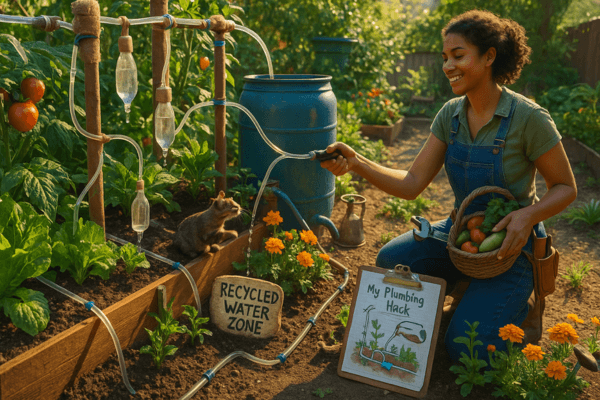
Install a Drip Irrigation System with Recycled Water: The Smart Gardener’s Plumbing Hack
Why Drip Irrigation Wins the Water Wars
While sprinklers waste 50% of water to evaporation and runoff, drip systems:
- Deliver 90% efficiency straight to roots
- Reduce fungal diseases (no wet leaves)
- Work with any water source – including your repurposed supplies
*”My water bill dropped $45/month after switching to drip + rain barrel combo!”*
— Ryan T., drought-conscious gardener, Los Angeles
Hook It Up: Connecting to Alternative Water Sources
Rain Barrel Setup
- Elevate your barrel (1 ft = 0.5 PSI pressure)
- Add filter screen (prevents clogging)
- Use 1/2″ mainline tubing with pressure regulator
Pro Hack: Install a Y-valve to toggle between tap and rainwater
Greywater Compatibility
✅ Works With:
- Laundry-to-landscape systems (L2L)
- Branched drain mulch basins
❌ Avoid:
- Micro-drippers (clog risk) → use soaker hoses instead
- Stored greywater → always use within 24 hours
DIY vs Pro: Choosing Your Adventure
$25 DIY Kit (Beginner)
✔ Wine bottle drippers (upside down with hole in cap)
✔ Hospital IV tubing repurposed as emitters
✔ Used soaker hoses from garage sales
$150 Semi-Pro (Intermediate)
✔ Timer-controlled manifold system
✔ Pressure-compensating drippers
✔ Rain sensor override
$500+ Pro Install (Worth It If…)
• You have 100+ sq ft garden
• Want smartphone control
• Need municipal rebates (check your water district!)
Maintenance Musts
🔍 Monthly: Flush lines (open ends for 30 sec)
🌱 Seasonally: Adjust emitter spacing as plants grow
❄️ Winter: Blow out lines with air compressor
*(Coming Next: [5. Self-Watering Planters – The Busy Gardener’s BFF])*
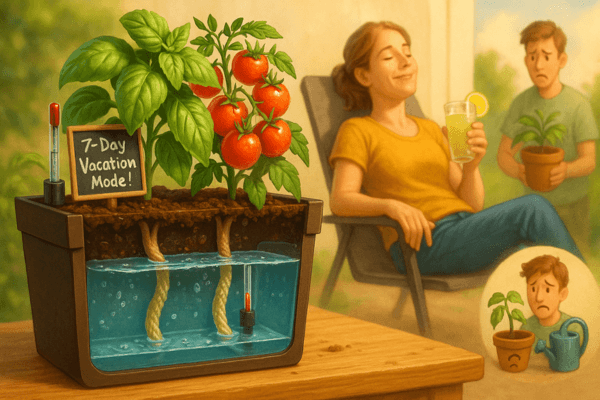
Create a Self-Watering Garden with a Water Reservoir: The Lazy Gardener’s Secret Weapon
How Self-Watering Systems Work (Without Electricity!)
These clever setups use capillary action—nature’s straw—to keep plants perfectly hydrated:
🌊 Wicking Bed Basics:
- Reservoir (bottom layer holds water)
- Wicking zone (fabric/gravel pulls water up)
- Soil layer (roots drink at their own pace)
*”My SIP (sub-irrigated planter) tomatoes survived a 2-week vacation—came home to happy plants!”*
— Naomi R., frequent traveler, Denver
Upcycled Reservoir Ideas (Free to $10)
1. 5-Gallon Bucket SIP
- Steps:
- Cut inner perforated container (from another bucket)
- Add PVC fill tube
- Use cotton rope wicks
Best for: Single large plants (tomatoes, peppers)
2. Storage Tote Wicking Bed
- Key hack: Use pool noodle pieces as floating water indicators
- Capacity: Waters plants for 10-14 days
3. Wine Barrel Oasis
- Pro tip: Drill overflow hole 2″ below soil line
- Plants: Dwarf fruit trees + herbs combo
Drought-Tolerant Plants That Thrive in SIPs
🌵 Herbs: Rosemary, thyme, oregano (hate wet feet)
🍅 Fruiting Plants: Cherry tomatoes, eggplants (consistent moisture lovers)
🌻 Flowers: Zinnias, marigolds (bloom non-stop)
Avoid: Carrots/radishes (taproots hate reservoirs)
The Maintenance Cheat Sheet
✅ Refill when indicator shows low (every 7-21 days)
✅ Flush reservoir monthly to prevent algae
✅ Winterize by draining completely
(Next Up: [6. Aquaponics – When Your Fish Feed Your Plants])
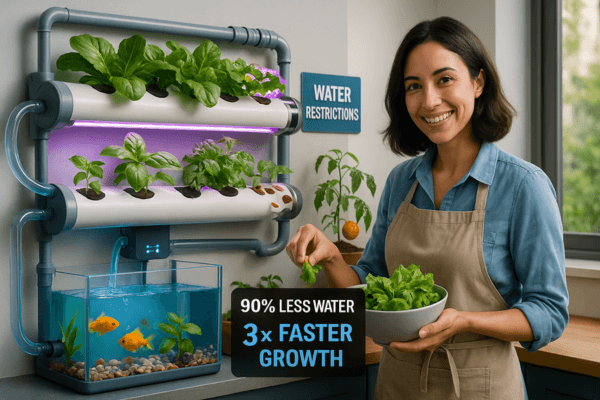
Use Aquaponics or Hydroponics: The Future of Water-Smart Gardening
How These Systems Work (And Why They Save 90% More Water)
💧 Hydroponics = Plants grow in nutrient-rich water (no soil)
🐟 Aquaponics = Fish waste feeds plants → plants clean water for fish
“My balcony aquaponics system uses just 10% of the water my old garden did—and grows 3x more food!”
— Liam K., apartment farmer, Chicago
Balcony-Sized Aquaponics (Small Space, Big Results)
The $100 Starter Kit
✔ Container: 20-gallon fish tank + grow bed
✔ Fish: 3-5 goldfish or minnows (hardy starters)
✔ Plants: Lettuce, basil, mint (heavy nutrient feeders)
Pro Tip: Use clay pebbles as grow media—they’re lightweight and pH-neutral.
Water-Saving Perks
- Closed-loop system (only top off evaporated water)
- No fertilizer needed (fish do the work)
- Grows year-round (indoor setups possible)
Hydroponic Herbs: The Ultimate Low-Waste Garden
5-Gallon Bucket DWC (Deep Water Culture)
- Cut holes in lid for net pots
- Add air stone + basic nutrients
- Grow 1 plant per bucket (thyme, oregano, kale)
Water Use: Just 1-2 gallons per week!
Kratky Method (No Electricity Needed)
- Perfect for: Beginners + off-grid growing
- How it works: Plants drink from static nutrient solution
- Best crops: Leafy greens, bush beans
Drought-Proof Plant Picks
🌿 Aquaponics All-Stars:
- Watercress (loves nitrates)
- Strawberries (fruit like crazy)
- Swiss chard (colorful + productive)
🥬 Hydroponic Heroes:
- Butterhead lettuce (ready in 30 days)
- Basil (grows twice as fast as in soil)
- Dwarf peppers (compact but prolific)
Maintenance Made Simple
🔍 Weekly: Check pH (6.0-7.0 for aquaponics, 5.5-6.5 for hydro)
💦 Monthly: Partial water changes (aquaponics)
🌡️ Always: Keep water temp 65-75°F
(Coming Next: [7. Mulching – The Invisible Water Saver])
Mulching: The Secret Sponge That Slashes Watering by 50%
Why Mulch is a Thirsty Garden’s Best Friend
Mulch isn’t just decoration—it’s a moisture-locking powerhouse that:
- Slows evaporation (like a lid on a coffee cup)
- Cools soil by up to 10°F (roots drink easier)
- Feeds worms that create water-holding tunnels
“After mulching my veggie beds with straw, I went from watering daily to just twice a week!”
— Sofia M., community gardener, Austin
Free Mulch Goldmines (Look Around You!)
1. Autumn Leaves (Nature’s Free Blanket)
- How to use: Shred with mower → apply 3″ thick
- Best for: Berry bushes & fruit trees
2. Grass Clippings (Instant Nitrogen Boost)
- Pro tip: Dry in sun first to prevent matting
- Avoid: Treated lawns (herbicide risk)
3. Cardboard (Weed-Smothering Superstar)
- Water hack: Soak before laying → worms will devour it
- Perfect under: Wood chips for new beds
Urban Bonus: Ask local coffee shops for free burlap sacks (great mulch covers)
The Art of Perfect Mulching
Thickness Guide
✅ Just right: 2-4 inches (your soil’s “sunscreen”)
❌ Too much: Over 6″ → creates soggy, moldy conditions
⚠️ Tree trunks: Keep mulch 3″ away to prevent rot
Mulch No-Nos
🚫 Rubber mulch (toxic & doesn’t decompose)
🚫 Fresh wood chips (steals nitrogen at first)
🚫 Pine needles (only for acid-lovers like blueberries)
Troubleshooting Mulch Mishaps
🍄 Fungal growth? → Stir mulch weekly for airflow
🐜 Pests moving in? → Add diatomaceous earth border
💦 Water pooling? → Switch to chunkier mulch (like wood chips)
*(Next Up: [8. AC/Dehumidifier Water – Your Forgotten Free Supply])*

Recycle Water from Dehumidifiers & AC Units: Your Hidden Water Source
Liquid Gold from Thin Air
That drip-drip from your appliances isn’t waste—it’s distilled H₂O perfect for plants!
- How it works: Moisture condenses on cold coils → collects in tanks
- Bonus: Naturally soft, chlorine-free water (pH ~7)
“My AC produces 2 gallons daily—enough to water all my houseplants for free!”
— Raj P., urban jungle enthusiast, Miami
Is Your Condensate Safe? The Metal Check
⚠️ Window Unit Warning:
- May contain copper/aluminum traces from coils
- Quick test: Leave water in clear glass overnight → check for sediment
✅ Safest Sources:
- Newer dehumidifiers (stainless steel components)
- Central AC systems (professional installations)
Smart Ways to Use Your “Air Water”
For Edible Plants (After Testing)
- Test pH (ideal: 6.0-7.0)
- Mix 1:1 with tap water to add minerals
- Best for: Leafy greens, herbs
For Houseplants & Ornamentals
- Tropical plants (peace lilies, monsteras) love it
- Orchids thrive on distilled water
- DIY terrariums benefit from pure H₂O
What to Expect: Daily Yields
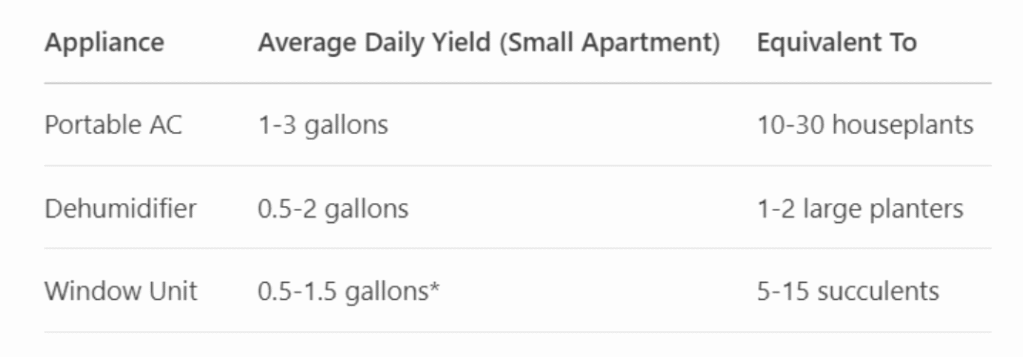
*Use caution with window units (see metal warning)
Pro Collection Hacks
🔹 Auto-Direct System: Attach hose to dehumidifier → drain into watering can
🔹 Storage Tip: Keep in sealed jugs (prevents mosquito breeding)
🔹 Boost Nutrients: Add 1 tsp Epsom salt per gallon for magnesium
(Coming Next: [9. Community Water Sharing – Multiply Your Impact])
Join or Start a Community Water-Sharing Program: The Ultimate Urban Water Hack
Why Share Water? More Than Just Savings
Imagine your neighbor’s shower water nourishing your tomato plants, while their rain barrels supply your herb garden during droughts. Community water sharing:
- Quadruples available resources by pooling systems
- Builds neighborhood resilience against water restrictions
- Cuts costs through shared equipment (like commercial filtration)
*”Our 10-household water co-op in Portland saves 12,000 gallons annually—enough to fill a swimming pool!”*
— The Green Street Collective
3 Ways to Launch Your Water Revolution
1. The Rainwater Bank
- How it works: Members deposit/withdraw harvested rain
- Tool library model: Borrow 55-gallon barrels or IBC totes
- Success story: Tucson’s Rainwater Harvesting Co-op
2. Greywater Brigades
- Team installs: Laundry-to-landscape systems for elderly/disabled neighbors
- Shared maintenance: Monthly pipe checks + detergent bulk buys
- Safety rule: Use only plant-friendly soaps (no softeners)
3. Apartment Building “Hydroponic Shares”
- Rooftop AC condensate collection for communal herb towers
- Balcony aquaponics teams (1 household tends fish, others tend plants)
Navigating the Legal Waters
📍 Check Local Codes First:
- Progressive areas: San Francisco allows shared greywater with permits
- Restrictive regions: Some states ban cross-property water transfer
🛡️ Liability Solutions:
- Memorandum of Understanding (MOU): Basic agreement template
- Insurance riders: Added to homeowner policies (~$50/year)
First Project Idea:
“Saturday Splash & Learn” – Install 3 rain barrels across yards in one day
(Next Steps: [Conclusion – Your Water-Wise Action Plan])
Every Drop Counts – Start Your Water Revolution Today
Small Changes, Big Waves
You don’t need a massive system to make a difference. Just one reused gallon per day adds up to 365 gallons saved annually—enough to:
🚿 Run 18 dishwasher cycles
🌱 Grow 10 pounds of lettuce
💧 Fill a 6-person hot tub
“I started with just a pasta water jar on my windowsill. Now my entire block shares rainwater!”
— Marisol G., urban water activist, Brooklyn
Your Challenge: Pick One & Begin
🔹 For the Time-Crunched: Try #3 (cooking water) or #8 (AC water)
🔹 For DIY Lovers: Build #5 (self-watering buckets) or #1 (rain barrel)
🔹 For Community Builders: Launch #9 (neighborhood water share)
Let’s Grow Together
Which idea excites you most?
👉 “I’m turning my dehumidifier into a plant oasis!”
👉 “Team rainwater bank with my neighbors!”
👉 “Testing greywater on my fruit trees!”
Drop your choice in the comments—we’ll feature the most creative implementations next month!
P.S. Tag #UrbanWaterWizard on social to join our water-saving movement.

